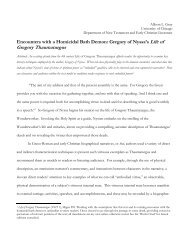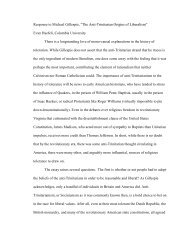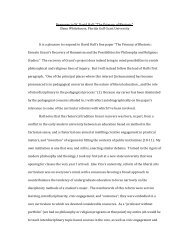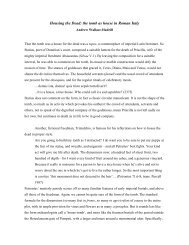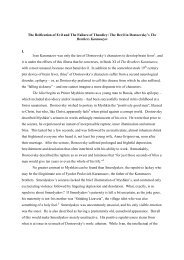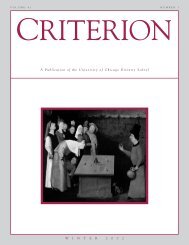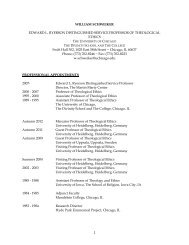Nota Bene - University of Chicago
Nota Bene - University of Chicago
Nota Bene - University of Chicago
Create successful ePaper yourself
Turn your PDF publications into a flip-book with our unique Google optimized e-Paper software.
etween the narrative and the epigram is much more integral and complex than that. At the<br />
least it seems to me likely that the epitaph has had an influential role in generating the order<br />
and substance <strong>of</strong> the legendary account, 27 with Augusta Faustina coming to life as the elusive<br />
βασι�λισσσα 28 <strong>of</strong> the epitaph (the author was apparently, unlike modern scholars, more<br />
interested in having his hero meet her than he was in recounting the church at Rome at the<br />
period!), and the travelogue <strong>of</strong> the inscription (Rome, Syria, Nisibis, Euphrates) 29 forming the<br />
center <strong>of</strong> the narrative. Yet what is most curious to me is that, even among scholars who find<br />
the discovery <strong>of</strong> the epitaph itself to provide striking confirmation <strong>of</strong> the historical reliability <strong>of</strong><br />
the vita Abercii, 30 the major narrative element in that literary work as we have traced it -- the<br />
role <strong>of</strong> the demon in both instigating Abercius’ journey to Rome and in procuring for him the<br />
stone for his funerary monument -- is not even mentioned. 31 At the very least this part <strong>of</strong> the<br />
tale should capture our interest because it is one way in which the literary author “saw” and<br />
interpreted the stone as well as the words upon it. Indeed, the author himself states that the<br />
Page 8<br />
monument was ambiguous depending upon the viewer: the sentence continues to describe the<br />
epigram τοι�ς με�ν α� ξι�οις του� Χριστου� νοου� μενον και� ω� φε�λιμον, τοι�ς δε� α� πι�στοις μη� γινωσκο� μενον<br />
ε�χον (“for those worthy <strong>of</strong> Christ it was understood and beneficial, but for the unbelievers it was<br />
------------------------------------<br />
27 Ramsay regarded the fashioning <strong>of</strong> the legends as inherently syncretistic: “In the Acta the historical<br />
Avircius Marcellus is transformed into the legendary St. Abercius ... He has become a centre round which has<br />
collected a religious myth, embodying both the popular conception <strong>of</strong> the early history <strong>of</strong> Christianity in Phrygia, and<br />
several local legends connected with natural features <strong>of</strong> the district ... The local legend may have contained some<br />
historical facts ... Any communication with M. Aurelius seems wholly improbable; and the incident <strong>of</strong> the Princess<br />
Lucilla is a threadbare tale that has done duty time after time, and was worked up by the author. This part <strong>of</strong> the<br />
Acta is probably to a considerable extent a free invention <strong>of</strong> the author, who has taken some trouble to fit his<br />
invention into the historical facts, though not always successfully. There was a strong inclination, shown in some<br />
other tales, to make the good Emperor Aurelius into a semi-Chr[istian] ” (Cities and Bishoprics <strong>of</strong> Phrygia, 1/2, pp.<br />
713-25). In general this assessment seems right, but it surprisingly gives the epitaph itself too small a role in the<br />
invention <strong>of</strong> the author.<br />
28 Merkelbach thinks the vita interprets this as the princess Lucilla ( “Grabepigramm,” 127).<br />
29 The trip to Rome receives proportionally more attention in both narrative and inscription ( §41-68), Syria<br />
(§69, with city-names Antioch, Apamea and Seleucia added), Nisibis across the Ephrates ( §70), with the discussion<br />
<strong>of</strong> how he was voted ι�σαπο� στολος there likely constituting an exegesis <strong>of</strong> the movement from v. 11a to 11b and 12a<br />
<strong>of</strong> the inscription (if not for the security <strong>of</strong> the omicron, on the basis <strong>of</strong> the narrative one would think the missing word<br />
at the end <strong>of</strong> line 11 would be συναποστο� λον [sc. Παυ�λον on next line])?<br />
30 Most recently Merkelbach, in several publications (see notes).<br />
31 Neither Merkelbach, Steinepigramme aus dem griechischen Osten , NewDocs 6, nor the earlier account<br />
by H. LeClerq in DACL, for instance, even mention the exorcistic episodes. Contrast the earlier insight <strong>of</strong> Lightfoot:<br />
“The legend however grew up about the literal interpretation; and, if we abandon the latter, the story <strong>of</strong> the interview<br />
with Lucilla and Faustina, which is the pivot <strong>of</strong> the narrative, falls to the ground” (Apostolic Fathers, vol. 1, pt. 2, p.<br />
498, italics added). It is the pivot, however, because <strong>of</strong> the exorcistic narrative that occasions both the journey and<br />
the funerary stone.




